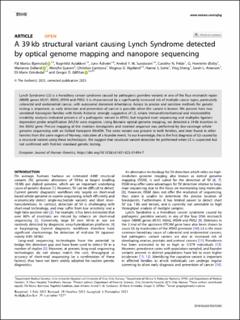| dc.contributor.author | Bjørnstad, Pål Marius | |
| dc.contributor.author | Aaløkken, Ragnhild Margrethe | |
| dc.contributor.author | Åsheim, June | |
| dc.contributor.author | Sundaram, Arvind | |
| dc.contributor.author | Nangota Felde, Caroline | |
| dc.contributor.author | Østby, Gina Henriette | |
| dc.contributor.author | Dalland, Marianne | |
| dc.contributor.author | Sjursen, Wenche | |
| dc.contributor.author | Carrizosa, Christian | |
| dc.contributor.author | Vigeland, Magnus Dehli | |
| dc.contributor.author | Sorte, Hanne Sørmo | |
| dc.contributor.author | Sheng, Ying | |
| dc.contributor.author | Ariansen, Sarah Louise | |
| dc.contributor.author | Grindedal, Eli Marie | |
| dc.contributor.author | Gilfillan, Gregor | |
| dc.date.accessioned | 2024-03-11T08:56:32Z | |
| dc.date.available | 2024-03-11T08:56:32Z | |
| dc.date.created | 2023-12-13T14:28:15Z | |
| dc.date.issued | 2023 | |
| dc.identifier.issn | 1018-4813 | |
| dc.identifier.uri | https://hdl.handle.net/11250/3121705 | |
| dc.description.abstract | Lynch Syndrome (LS) is a hereditary cancer syndrome caused by pathogenic germline variants in one of the four mismatch repair (MMR) genes MLH1, MSH2, MSH6 and PMS2. It is characterized by a significantly increased risk of multiple cancer types, particularly colorectal and endometrial cancer, with autosomal dominant inheritance. Access to precise and sensitive methods for genetic testing is important, as early detection and prevention of cancer is possible when the variant is known. We present here two unrelated Norwegian families with family histories strongly suggestive of LS, where immunohistochemical and microsatellite instability analyses indicated presence of a pathogenic variant in MSH2, but targeted exon sequencing and multiplex ligation-dependent probe amplification (MLPA) were negative. Using Bionano optical genome mapping, we detected a 39 kb insertion in the MSH2 gene. Precise mapping of the insertion breakpoints and inserted sequence was performed by low-coverage whole-genome sequencing with an Oxford Nanopore MinION. The same variant was present in both families, and later found in other families from the same region of Norway, indicative of a founder event. To our knowledge, this is the first diagnosis of LS caused by a structural variant using these technologies. We suggest that structural variant detection be performed when LS is suspected but not confirmed with first-tier standard genetic testing. | en_US |
| dc.language.iso | eng | en_US |
| dc.publisher | Springer Nature Ltd. | en_US |
| dc.rights | Navngivelse 4.0 Internasjonal | * |
| dc.rights.uri | http://creativecommons.org/licenses/by/4.0/deed.no | * |
| dc.title | A 39 kb structural variant causing Lynch Syndrome detected by optical genome mapping and nanopore sequencing | en_US |
| dc.title.alternative | A 39 kb structural variant causing Lynch Syndrome detected by optical genome mapping and nanopore sequencing | en_US |
| dc.type | Peer reviewed | en_US |
| dc.type | Journal article | en_US |
| dc.description.version | publishedVersion | en_US |
| dc.source.pagenumber | 1-8 | en_US |
| dc.source.journal | European Journal of Human Genetics | en_US |
| dc.identifier.doi | 10.1038/s41431-023-01494-7 | |
| dc.identifier.cristin | 2213114 | |
| cristin.ispublished | true | |
| cristin.fulltext | original | |
| cristin.qualitycode | 1 | |

